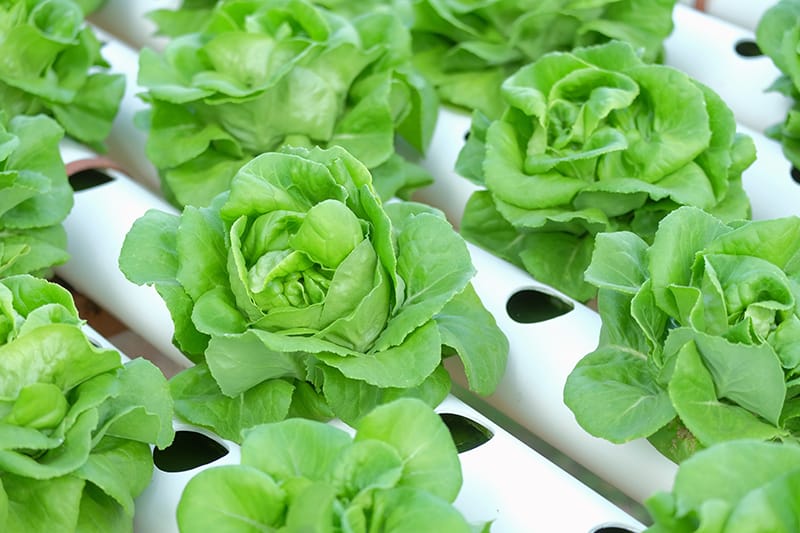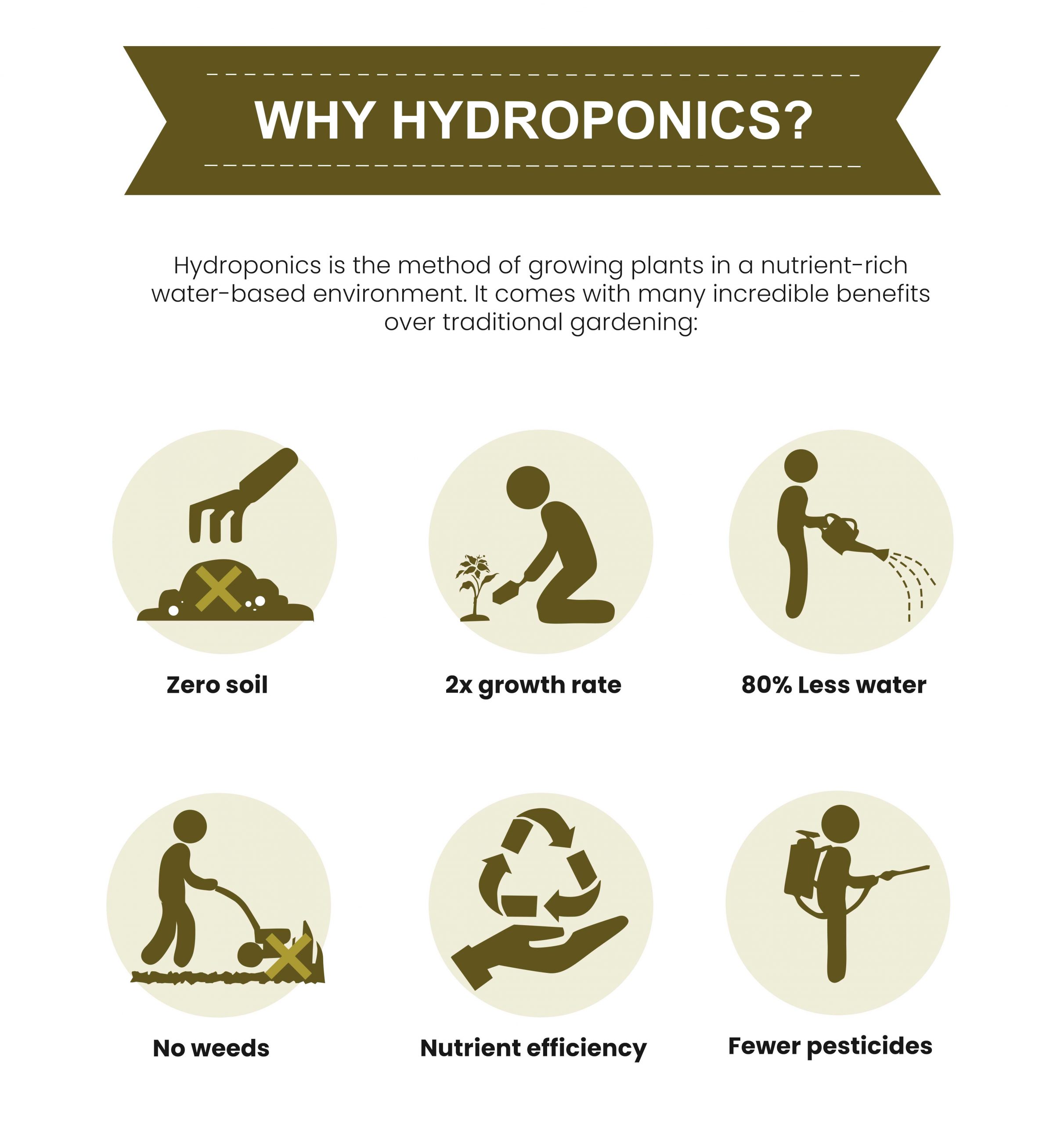https://www.trees.com/gardening-and-landscaping/advantages-disadvantages-of-hydroponics

Over the last decade, people’s interest in how their food is produced has increased greatly. More consumers want “safe” food that’s been produced with sustainable, mindful growing practices and is free from pesticide residues. As a result, more consumers are choosing to grow their own food and many are exploring hydroponics for doing so.
If you’re thinking of embarking on a hydroponics project, you’ll first need to learn the fundamental concepts of growing plants hydroponically. On this page, you’ll discover the basics of hydroponics as well as the advantages and disadvantages of using a hydroponics system.
What Is Hydroponics?
Hydroponics is a method of growing plants indoors without using any soil. Instead of pulling mineral nutrients needed for growth from the ground, plants get all of their nutrition through a nutrient solution supplied to their roots.
Hydroponics works in a variety of scenarios—from growing a small collection of herbs in a kitchen all the way up to numerous plants in a large-scale commercial operation. People with limited or no outdoor space, such as urban residents, apartment dwellers, or renters who can’t have an outdoor garden, find hydroponic growing especially useful.
Many types of plants grow well hydroponically. Some of the best plants to grow in a hydroponics system include herbs, lettuce and greens, tomatoes, peppers, and strawberries. As a rule, avoid plants that grow tall like corn, have deep taproots like potatoes, or grow in a vining nature.
How Does a Hydroponics System Work?

While plant growth involves many metabolic processes, plants grow primarily because of three main items: essential nutrients, water, and sunlight. In a traditional garden, soil anchors the plant and acts as a reservoir for water and nutrients. A hydroponics system eliminates the need for soil by providing a nutrient-charged aqueous solution directly to the roots that keeps the plant fed and hydrated, while supplemental lighting solutions mimic sunlight.
More on soil-free growing
In a hydroponics growing system, plants are either suspended directly in the aqueous solution or grown in a soil-free medium such as coconut coir, rock wool, LECA, vermiculite, or perlite. The plant’s roots receive the nutrient solution in either an active system or a passive system.
- Active systems use pumps to circulate and aerate nutrient solutions, delivering the nutrients to the plant’s root zone for uptake.
- Passive systems have no pumps or moving parts. The nutrient solutions are fed to the root zone through flooding, gravity, or capillary action.
More on supplemental lighting
Because natural light is limited indoors, plants grown in a hydroponics system typically receive supplemental lighting. Hanging lights above the plants and controlling their brightness mimics the natural cycles of daylight and darkness that plants need to grow.
7 Advantages of Hydroponics for Gardeners

While it may sound complex, growing plants in a hydroponics system has many benefits. Some of the most notable include:
1. An extended growing season
Cold climates with chilly winter temperatures and shorter day lengths prohibit plant growth. But with a hydroponics system, plants can be grown hydroponically year-round because the grower controls the temperature, light, and nutrient-supply.
2. Improved growth and yield
Hydroponics systems typically result in faster-growing, higher-yielding plants. This is likely due to the increased oxygen levels found in the nutrient solution and the carefully controlled environmental factors. By increasing a plant’s oxygen levels, you stimulate root growth and enhance nutrient uptake. These optimal growing conditions equate to less stress on plants and a more bountiful harvest.
3. Higher plant density
Plants grown in soil have rigid spacing guidelines that must be followed to allow each plant equal access to the soil’s somewhat limited supply of water and nutrients. Because hydroponics systems deliver a more nutrient-charged solution to the root zone, plants can be grown closer together without competing for root space.
4. Plants can grow anywhere
Unlike traditional gardens that require outdoor space for plants, hydroponics systems are easily incorporated into many homes, regardless of their size or location.
5. Less water consumption
Even though hydroponic systems depend primarily on water to grow plants, they use between 80 to 90% less water than plants grown in the ground. In traditional gardening, a large amount of water is applied to the soil to allow adequate moisture to reach the root zone. When moving through the soil, the water evaporates and only a percentage of it reaches the roots.
In hydroponics, the water immediately reaches the roots, with little lost to evaporation. In many systems, the nutrient solution is also recirculated multiple times before becoming unusable and discarded, further improving water efficiency.
6. Fewer pest problems
Because hydroponics systems are indoors, pests aren’t as prevalent and have controlled entrances. Insects find it more challenging to infiltrate the system and attack plants. Plus, fewer pest problems mean little to no need for pesticides.
7. Easier to harvest mature plants
Plants grown in hydroponics systems are typically grown on counters, benches, tables, etc., which puts them at waist height for most growers. At this height, mature plants are easier to harvest since there’s no need to bend down or kneel to reach the plants. This is an important advantage for growers with limited mobility or physical ailments that prevent them from gardening at ground-level.
5 Disadvantages of Hydroponics

It’s easy to see the advantages of hydroponics. But some distinct disadvantages exist. As with anything, it’s essential to understand the drawbacks to avoid surprises.
1. Expensive to set up
Compared to a traditional garden, a hydroponics system is more expensive to acquire and build. Costs range depending upon the type and size of the system purchased, and whether or not it’s prefabricated or built with individual components to create a customized design.
2. Vulnerable to power outages
Both passive and active hydroponics systems depend on electricity to power the different components such as grow lights, water pumps, aerators, fans, etc. Therefore, a power outage will affect the entire system. In active systems, a loss of power can be detrimental to plants if it goes unnoticed by the grower.
3. Requires constant monitoring and maintenance
Hydroponics requires a higher level of monitoring and micro-managing than growing plants traditionally. To maintain a carefully controlled growing environment, all system components need constant vigilance—lights, temperature, and many aspects of the nutrient solution such as pH and electrical conductivity. The nutrient solution also needs to be flushed and replaced regularly, and the system parts cleaned often to prevent buildup and clogging.
4. Waterborne diseases
Because hydroponically grown plants are grown in water instead of soil, waterborne diseases are considerably higher. With the water circulating continuously through the system, infections can spread quickly throughout the growing system as a whole, affecting the whole collection of plants. In extreme cases, a waterborne disease can kill all the plants in a hydroponics system within hours.
5. Problems affect plants quicker
Soil protects the roots from extreme temperature changes, slows diseases and pests from attacking, and regularly releases and absorbs nutrients. Without soil to act as a buffer, plants grown in hydroponics systems react negatively to problems like nutrient deficiencies and disease much quicker.
Should You Try Hydroponics at Home?
Absolutely. Hydroponics is a great way to try growing healthy plants at home without the use of soil. While it may seem counterintuitive, plants grown in hydroponics have higher yields and present a host of other advantages. Just remember to watch out for the pitfalls along the way.

Comments
Post a Comment